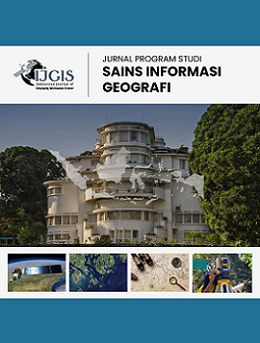Mapping Potential Areas For Solar Power Sources In East Sumba Regency Based On Remote Sensing And Geographic Information System
Abstract
East Sumba Regency is an area with high solar radiation, which reaches 5.7 kWh/m² per day. Mapping of potential PLTS source areas is important to support the development of renewable energy in areas that are largely unreached by conventional energy infrastructure. This research aims to map the potential of PLTS in East Sumba Regency based on remote sensing and Geographic Information System (GIS) which is expected to be a reference for regional development in East Sumba Regency. The methods used are classification, overlapping, scoring, and weighting of each parameter. The parameters used are land surface temperature, slope, distance from the road, and land cover. The results of the analysis show that potential PLTS source areas can be classified into five categories, namely very potential, potential, quite potential, not potential, and very not potential. Each class has a diverse area of 13% for very potential areas, 19% for potential areas, 41% for moderately potential areas, 18% for non-potential areas, and 9% for very non-potential areas. These results show that East Sumba Regency is quite potential as a source of solar power plants. In order to accelerate the national agenda in increasing the proportion of renewable energy and reducing dependence on fossil fuels, it is hoped that this research can be a reference for the development of sustainable energy policies in the area.
Full Text:
PDFReferences
Al Hakim, R. R. (2020). Indonesia Energy Model, A Review of Renewable Energy Potential for Energy Security in Indonesia: A Review. ANDASIH Journal of Community Service, 1(1), 1-11.
Alim, M. S., Thamrin, S., & RL, W. (2023). Utilisation of Solar Power Plant as an Alternative for Future National Energy Security. Journal of Community Service Nusantara (JPkMN), 4(3), 2427-2435.
Central Bureau of Statistics (2023)
Hakim, R. R. A. (2020). Indonesia Energy Model, Review of Renewable Energy Potential for Energy Security in Indonesia: Literature Review. ANDASIH Journal of Community Service, 1, 1-10.
Hartono, J., Hastuti, H.S., Halimatussadiah, A., Saraswati, A., Mita,
A.F., Indriani, V., (2020). Comparing the impacts of fossil and renewable energy investments in Indonesia: A simple general equilibrium analysis. Heliyon, 6(6). e04120. ISSN 2405-8440. https://doi.org/10.1016/j.heliyon.2020.e04120.
Islam, M. R., Aziz, M. T., Alauddin, M., Kader, Z., & Islam, M. R. (2024). Site suitability assessment for solar power plants in Bangladesh: A GIS-based analytical hierarchy process (AHP) and multi-criteria decision analysis (MCDA) approach. Renewable Energy, 220, 119595.
Ministry of Energy and Mineral Resources, 2020
Kumara, I. N. S., Urmee, T., Divayana, Y., Setiawan, I., Pawitra, A., & Jaya, A. (2018, October). Implementation of Grid-connected PV Plant in remote location in Sumbawa Island of Indonesia: Lesson learnt. In 2018 International Conference on Smart Green Technology in Electrical and Information Systems (ICSGTEIS) (pp. 203-209). IEEE.
Refbacks
- There are currently no refbacks.

